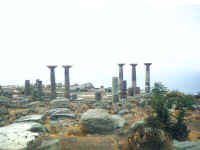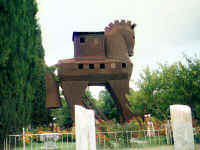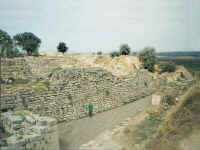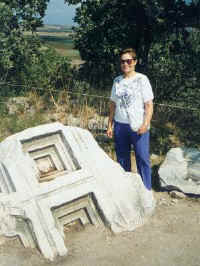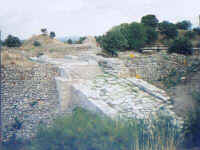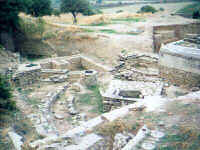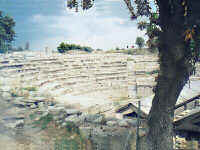Page 1 2 3 4 5 6 7 8 9 10 11 12 13 14 15 16 17 18 19 20 21 22 23 Friday, September 29: We awoke to the sound of waves crashing on the breakwater. It was partly cloudy and very windy, much cooler than the day before. Nevertheless, we had breakfast outside along the water. It was our first breakfast in Turkey, and we found as we traveled that it was typical: boiled eggs; sliced sausage and cheese; bread with honey or jam; tomatoes; cucumbers; olives; and coffee. There was also watermelon, which we never were served for breakfast anywhere else. After checking out of the hotel, we made our way back up the paving stone road to the top of Mount Assos. It didn't seem as bad going up as it had coming down. We drove into the old walled city and found people still lived in the lower parts of it. Unfortunately, just as we walked up to the ruins on top, it started raining very hard. It soon passed, however, and we explored the ruins of the Temple of Athena. The view was fantastic, but the wind nearly blew us off the mountain. Assos was first occupied about 1000 B.C. Aristotle lived and taught there for three years in the 4th Century B.C., marrying the daughter of its ruler. The city was last occupied by the Ottomans in the 14th Century. As we left, we stopped to view the long, arched bridge built by Sultan Orhan over the Behram River at that time. The road no longer passes over the one lane bridge, and we had missed seeing it as we approached Assos the evening before. We made our way back to the main highway and headed north toward Troy (Truva). We arrived around 10:30. As we left the main road, we could see Canakkale to the north, a large walled city jutting into the waters of the Dardanelles. In a way, this is a later iteration of Troy, which also was a walled city guarding the entrance to that strategic waterway. By the time we reached Troy, it was mostly cloudy and threatening rain. There were only a few other people there. The first thing we did was to climb into the 40-foot high wooden horse standing near the entrance. Then we went to the small building maintained by the nonprofit organization doing continuing excavation at Troy. Several of their excellent books and diagrams were on display under glass, but you couldn't buy any of them there. The separate gift shop did not have any of those materials either. In fact, it didn't have a single accurate, up-to-date guide book for sale. This was a big disappointment for me. Since first reading the Iliad and the Odyssey in high school, it had been my ambition to see the Troy that Homer wrote about. I had counted on finding excellent guidebooks at such an important site. Moving on to the ruins, we found that, while there had been some restoration of walls and towers, little else could be recognized beside a large ramp leading to one of the city gates and a small amphitheater. Of course, that is to be expected of a site thousands of years old. Probably the most interesting aspect was to see the nine different levels, reflecting the nine different cities built on the site between 2500 B.C. and the Roman occupation that ended about 400 A.D.
In some places, you could see the walls of four different levels in the space of just a few yards. Although the issue has never been settled definitively, many archaeologists believe that Troy VII is most likely Homer's Troy. The city at that level was sacked by the Greeks around 1250 B.C. We left Troy about 12:30 and headed back south. Until then, we had at least an occasional glimpse of sun, but it clouded up completely and started to rain very hard. We stopped at a little roadside restaurant for a lunch of a few meses, salad, and shish kebab. We had hoped to spend the late afternoon and night at Ayvalik, an attractive coastal town of 25,000. As we drove along the waterfront, though, we found it very congested, and it was still pouring. Consequently, we decided to press on to Bergama, spending the miserable day driving instead of sitting in a hotel room. It was dusk as we entered Bergama. We stopped at the first group of hotels we saw on the main road, and registered at the Serpion. We took a room on the back side, away from the noise of the highway. There was no restaurant, so we had to go out for dinner. The hotel manager, who spoke German, recommended the Saglam (Salaam), " just 500 meters" down the road. The rain had stopped, and we considered walking to the restaurant since it was so close. But it was very dark so we decided to drive - fortunately. We drove at least a kilometer without finding the place and stopped to ask directions, using a card with the name and address of the restaurant to help us communicate. The person we asked indicated it was 500 meters ahead. We drove more than that, then stopped to ask again. This Turk said it was still 500 meters ahead, and he was right. Apparently the Turks use "500 meters" for distance like the Italians use "domani" for time, an indefinite term that really means not too far ahead. As we entered the Saglam, it wasn't too impressive. But then, in fair English, they asked if we'd like to eat in "a Turkish house." They led us to a large room in an adjoining building. It was elaborately decorated and filled with Turkish artifacts. We sat on long upholstered benches at a "U" shaped table that ran along three sides of the room. At least 40 people could have sat at that table, but we were the only ones there. Later we saw another group of people being seated in a similar room next to ours. We let the chef surprise us with an assortment of seven meses. Then we had chicken kebabs over rice, with tomatoes and watercress. We ordered our first Turkish wine, a delicious red (Dickman brand). It was a very leisurely and relaxing meal, just what we needed after driving over four hours in the rain. We drank about half the wine and took the bottle with us. The food and service had been excellent. Back at the hotel, we sat on our balcony for a while before turning in. The view wasn't much (a fairly busy side street with a lot of construction along it), but it was nice just to sit and relax. Page 1 2 3 4 5 6 7 8 9 10 11 12 13 14 15 16 17 18 19 20 21 22 23 |

